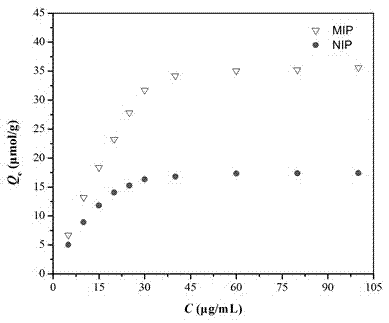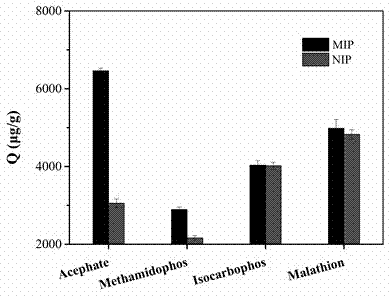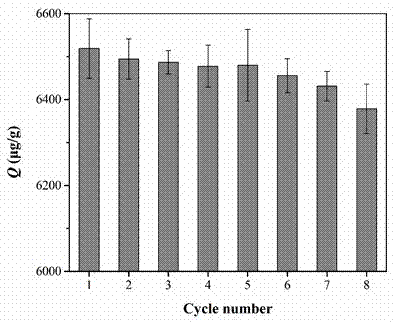Preparation method and application of acephate molecularly imprinted polymer
An acephate, molecular imprinting technology, applied in chemical instruments and methods, water pollutants, water/sludge/sewage treatment, etc., to achieve the effects of simple preparation method, reduced harm, and simple regeneration method
- Summary
- Abstract
- Description
- Claims
- Application Information
AI Technical Summary
Problems solved by technology
Method used
Image
Examples
Embodiment 1
[0034] (1) Preparation of oil phase: Dissolve acephate (0.5mmol) in chloroform (0.5mL) solution, add methacrylic acid (MAA, 1.5mmol), mix well, and after standing for a certain period of time, add crosslinking agent Ethylene glycol dimethacrylate (EGDMA, 7.5 mmol) and initiator azobisisobutyronitrile (AIBN, 20 mg);
[0035] (2) Preparation of water phase: a certain amount of nano-silica particles (Nano-SiO 2 , 0.2g) into deionized water (6mL), ultrasonically dispersed;
[0036] (3) Preparation of Pickering emulsion: quickly transfer the oil phase prepared in step (1) to the water phase prepared in step (2), and adjust the pH with sodium hydroxide solution. After vigorous shaking, ultrasonic treatment forms Pickering emulsion;
[0037] (4) Preparation of molecularly imprinted polymerization: Pass the Pickering emulsion prepared in step (3) through N 2 (5min) Deoxygenate, seal, thermally initiate polymerization in a 60°C water bath for 16h, centrifuge the obtained polymer par...
Embodiment 2
[0040] (1) Preparation of oil phase: Dissolve acephate (1.0mmol) in chloroform (1.0mL) solution, add methacrylic acid (MAA, 3.0mmol), mix well, let stand for a certain period of time, then add cross-linking agent Ethylene glycol dimethacrylate (EGDMA, 15.0 mmol) and initiator azobisisobutyronitrile (AIBN, 20 mg);
[0041] (2) Preparation of water phase: a certain amount of nano-silica particles (Nano-SiO 2 , 0.4g) into deionized water (12mL), ultrasonically dispersed;
[0042] (3) Preparation of Pickering emulsion: quickly transfer the oil phase prepared in step (1) to the water phase prepared in step (2), and adjust the pH with sodium hydroxide solution. After vigorous shaking, ultrasonic treatment forms Pickering emulsion;
[0043] (4) Preparation of molecularly imprinted polymerization: Pass the Pickering emulsion prepared in step (3) through N2 (5min) Deoxygenate, seal, thermally initiate polymerization in a 60°C water bath for 16h, centrifuge the obtained polymer partic...
Embodiment 3
[0046] (1) Preparation of oil phase: Dissolve acephate (1.5mmol) in chloroform (1.5mL) solution, add methacrylic acid (MAA, 4.5mmol), mix well, and after standing for a certain period of time, add crosslinking agent Ethylene glycol dimethacrylate (EGDMA, 22.5 mmol) and initiator azobisisobutyronitrile (AIBN, 20 mg);
[0047] (2) Preparation of water phase: a certain amount of nano-silica particles (Nano-SiO 2 , 0.6g) into deionized water (18mL), ultrasonically dispersed;
[0048] (3) Preparation of Pickering emulsion: quickly transfer the oil phase prepared in step (1) to the water phase prepared in step (2), and adjust the pH with sodium hydroxide solution. After vigorous shaking, ultrasonic treatment forms Pickering emulsion;
[0049] (4) Preparation of molecularly imprinted polymerization: Pass the Pickering emulsion prepared in step (3) through N 2 (5min) Deoxygenate, seal, thermally initiate polymerization in a 60°C water bath for 16h, centrifuge the obtained polymer p...
PUM
 Login to View More
Login to View More Abstract
Description
Claims
Application Information
 Login to View More
Login to View More - R&D
- Intellectual Property
- Life Sciences
- Materials
- Tech Scout
- Unparalleled Data Quality
- Higher Quality Content
- 60% Fewer Hallucinations
Browse by: Latest US Patents, China's latest patents, Technical Efficacy Thesaurus, Application Domain, Technology Topic, Popular Technical Reports.
© 2025 PatSnap. All rights reserved.Legal|Privacy policy|Modern Slavery Act Transparency Statement|Sitemap|About US| Contact US: help@patsnap.com



